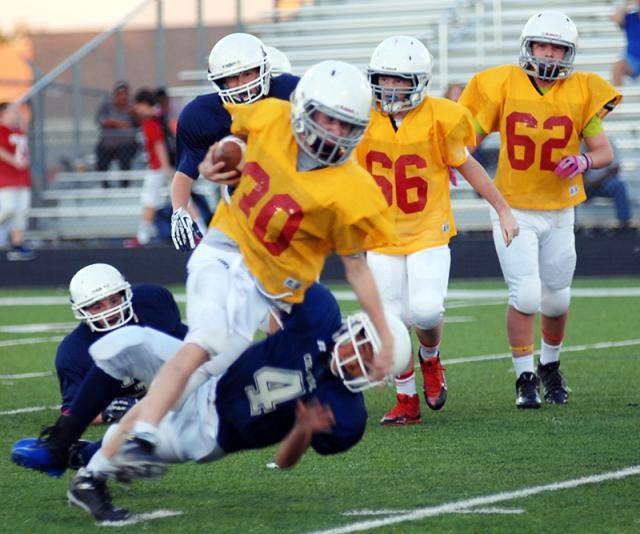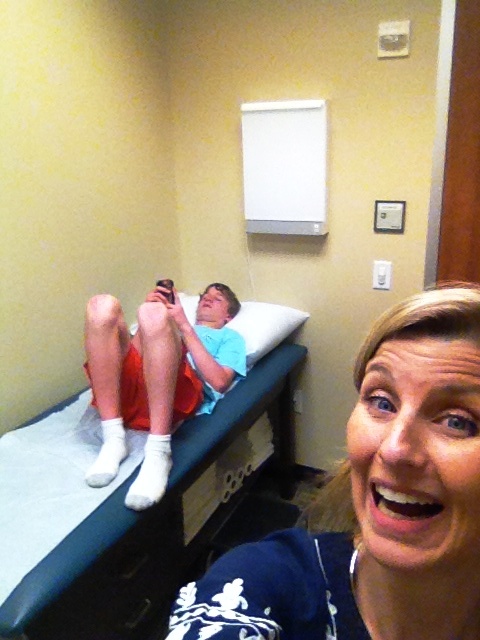As we head into the last month of the school year (at least for some of us), parents start asking each other, "Hey, what is your kid doing this summer? ("Translation for non-Texans: "What sports is your child playing this summer?")
As lots of sports parents know, summer does not always mean fun and hanging out by the swimming pool anymore. In this deeply sports-obsessed state, there is no off-season. Ever! 
Back in February, spring and summer could not get here fast enough. I was looking forward to watching my 13-year-old run track, play basketball, compete in skeet shooting (Skeet? Remember, we live in Texas!), and most of all, play our summer sport favorite, 7-on-7 football.
But then our plans for a sports-filled 6 months got derailed, and since then I have been dreading having to answer that question. For a while, I didn't even have any answer, because I didn't know.
At least now I know. When the next smiling parent asks me what my son is doing this summer, my answer will be, "Physical Therapy."
No, I won't say it with a frown; I will say it with enthusiasm and encouragement. That's because our family is going to treat PT as any other competitive sport. There will be challenges, there will be victories, and there wil likely be setbacks. I know there will be lessons learned along the way. I also pray for a short season, for once not hoping for a long run into the postseason in this new sport. Most of all, I am grateful that, at the very least, our son has finally healed to the point that he is ready to begin physical therapy.
Injuries: a part of the game
As a parent of a child involved in competitive sports, you assume the risk of injury. Every time your child suits up and walks on the field, you realize that accidents can and will happen. Every mom breathes a sigh of relief when the final whistle blows and their kid is still vertical. We even watch for signs of the injury we cannot see, such as concussions. I quiz my son after every game to see if he knows the alphabet backwards, the Vice President's first name, and the day of week and the year after every football game. (I am just cautious like that.)
So, I ask myself time and time again, how and why did my son get injured? How did this happen and how could we as parents prevented it. More importantly, how can we keep it from happening again? As National Youth Sports Safety Month comes to a close, I am here to share a cautionary tale about my son's injury, hoping that, in doing so, I can help another parent - another safety-conscious mom like me - to prevent the same kind of injury from happening to their child. (Just so you know, this blog is the first of what I am planning to be a series reporting on my son's recovery and offering additional thoughts about sports safety along the way)
Breaking Bad
My tale starts at the end of January. It was a very exciting time because it was the beginning of tryouts for spring middle school track. My son may not look fast, but he covers a lot of ground quickly, a lot like a baby giraffe loping along on the great plains of Africa! He was an odd-on favorite to fill many key spots on the team, including the relay races. It would have been a real honor for kid like mine, who is a taller and larger than most of his schoolmates.
Every day he came home from school to tell us the times he was clocking in practice. But he would also complain about how his lower back was hurting. I know that back pain is common in boys, and is also common in runners. (My husband and I both run, so we know that first hand!) His reports of back pain continued almost every day of track try-outs. He complained to his skills coach about his back. His coach just thought he was tired, or tight from running. Lots of ice, heating pads and Aleve got us through three weeks of try-outs and the first week of practice. Our son was slated to compete in a bunch of different running events and all the relays. We were proud he posted a top 3 time in all events he entered.
Backing off
On the first Thursday of the season, the athletic trainer for the middle school sports teams called me with a recommendation that my son see a doctor as soon as possible about his back pain. I was concerned, obviously, but I thought perhaps he just needed something stronger to heal a pulled muscle or tendon.
I immediately called a dear family friend, who happens to be a top orthopedic surgeon in town. Lucky for us, he is also our high school football team's doctor on Friday nights. Our doctor friend called the athletic trainer and called me back immediately. He said he would see my son at 1:30. The office would be expecting us.
 After X-rays and a physical exam, the doctor took us to the x-ray room to look at film. He circled two teeny tiny lines on one of the vertebrae - the L-3 lumbar to be exact. The diagnosis: a fractured spine! The shock and horror began to set in. Even if it is one of your favorite people on earth telling you that your child has a broken back, and he is being as optimistic and gentle as a surgeon can be, it was an overwhelming, out-of-body, room-spinning experience.
After X-rays and a physical exam, the doctor took us to the x-ray room to look at film. He circled two teeny tiny lines on one of the vertebrae - the L-3 lumbar to be exact. The diagnosis: a fractured spine! The shock and horror began to set in. Even if it is one of your favorite people on earth telling you that your child has a broken back, and he is being as optimistic and gentle as a surgeon can be, it was an overwhelming, out-of-body, room-spinning experience.
My son was the composed one in the room. He had the sense to ask how do we heal it? Further testing would be needed, and while the good news was that a stress fracture of this type did NOT require surgery, and he didn't need to be in a cast, the bad news was that there was nothing for him to do but shut it down, and give the injury time to heal (time may not heal all wounds, but I guess the aphorism was apppropriate here). The tricky part was that no one knew how long it would take. Much like a concussion, the back heals on its own time schedule. So, until the vertebrae healed, our "go 90 mph or nothing" son faced a spring of nothing, except going to school and coming home to do his homework and watch TV.
I will resist the temptation to complain. There are so many people going through recoveries and illnesses that are painful. But sometimes nothing can be painful, too. In less than 5 minutes, my child went from looking forward to the fun of basketball games, skeet tournaments, track meets, 7 on 7 football, fishing in the creek, and spring turkey season, to sitting, watching, and waiting, which, as anyone who has or has ever had a 13-year-old boy knows, would be extremely hard. So, we had to do nothing for almost 8 weeks.
Time ... is on his side
As I began to tell friends and parents about our son's diagnosis and the recovery process, I realized we were not alone! I thought a fractured spine was an odd and unique injury. Among a close group of 20 mothers, I quickly learned that five had sons, older than my boy, who had gone through the exact same thing when they were about his age! When I expanded the circle, I found more parents who had children suffer the same injury.
I asked the orthopedic surgeon that my doctor friend had referred us to just how common is this injury? He said he sees it in his practice 250 times a year. Mostly boys just like my son - growing tall and athletic. I asked how many of them heal totally. He said 248. I asked how long does this take. He said it just takes time; you just do not know - 3 months? 6 months? 9 months? In some cases a year! A year? Of sitting on the couch and watching TV? Are you kidding me?? The answer was a very calm, "Yes, Ma'm. That is what you do, and pray that you are not one of the two out of 250!"



















